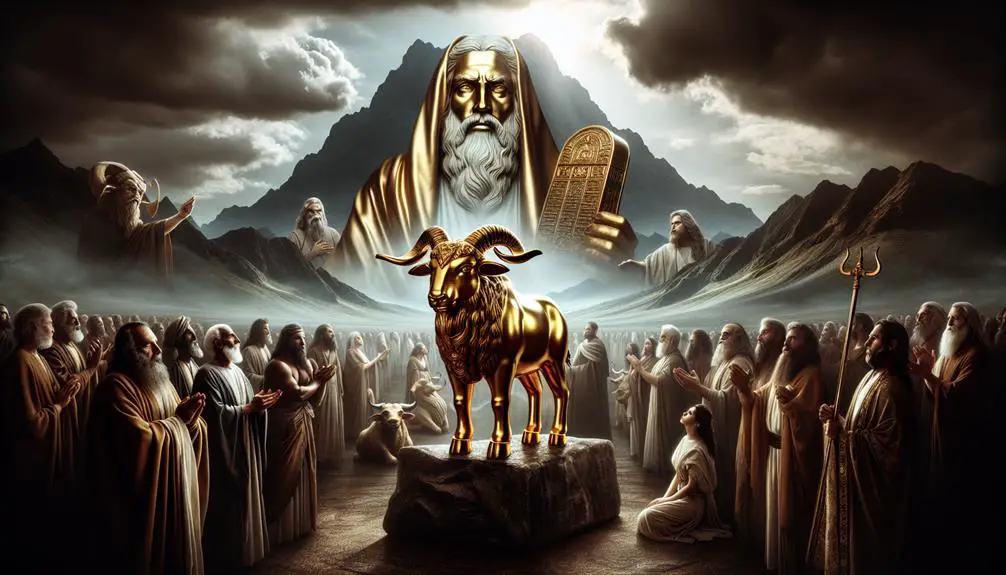Discover the tales of false religions in the Bible, revealing the thin line between faith and folly.

False Religions in the Bible
You might not be aware, but the Bible is replete with instances of false religions that were as diverse as they were controversial. From the infamous Golden Calf incident, which sparked divine wrath, to the subtle yet pervasive worship of Baal and Asherah, these stories offer more than a glimpse into the spiritual conflicts of ancient times.
They also contain profound lessons on faith, idolatry, and the consequences of turning away from established doctrines. As we explore these narratives, you'll find yourself questioning the very nature of belief and the fine line between true devotion and misguided worship.
Why should this matter to you? Well, the answers might surprise you.
Key Takeaways
- The Bible depicts idolatry as a direct challenge to monotheistic faith, leading to societal and spiritual consequences.
- Notable instances like the Golden Calf and Baal worship illustrate Israelites' recurrent struggle with polytheistic practices.
- Figures such as Moses and Elijah played crucial roles in combating idolatry and reaffirming Yahweh's sovereignty.
- The narratives warn against false prophets and underscore the importance of adhering to true monotheistic worship.
The Golden Calf Incident

The Golden Calf incident, as detailed in the Bible, represents a pivotal moment of apostasy among the Israelites, showcasing their turn to idolatry during Moses' absence on Mount Sinai. This episode not only underscores the fragility of human faith but also highlights Moses' pivotal role as an intercessor between the divine and his people.
Upon descending from the mountain and witnessing the idolatrous acts, Moses' anger becomes a focal point of the narrative. His visceral reaction, including the shattering of the stone tablets inscribed with the commandments, symbolizes the broken covenant between Yahweh and the Israelites.
The repentance process that follows is equally significant. It illustrates a complex journey back to divine favor, involving both Moses' advocacy and the Israelites' realization of their sin. This process isn't immediate or simple; it requires genuine acknowledgment of wrongdoing and a willingness to atone. Moses' intercession, pleading with Yahweh to forgive their transgression, underscores the necessity of sincere repentance and the possibility of restoration despite grave sin.
Analyzing this incident reveals the intricate dynamics of faith, leadership, sin, and redemption in the biblical narrative, offering profound insights into human nature and divine mercy.
The Baal Worshipers

Worship of Baal, a practice that infiltrated Israelite society, marks another significant deviation from monotheistic faith, reflecting broader themes of apostasy and cultural assimilation in biblical accounts. You observe that Baal, considered a fertility god by the Canaanites, became appealing to some Israelites, leading them away from their exclusive worship of Yahweh. This shift wasn't merely religious but also indicated the blending of cultures and the erosion of distinct Israelite identity.
Baal rituals, which included offerings and possibly human sacrifices, stood in stark contrast to the worship practices commanded by Yahweh. These rituals underscore the depth of Israel's apostasy, as they engaged in practices abhorrent to their original faith.
Elijah's challenge on Mount Carmel serves as a pivotal moment in the confrontation between the worship of Yahweh and Baal. You'll find this narrative illustrative of the struggle between monotheism and polytheism within Israel. Elijah's triumph, calling down fire from heaven, not only discredited the prophets of Baal but also underscored the power of Yahweh over the gods of the surrounding nations, aiming to steer the Israelites back to their foundational faith.
Idolatry in Babylon

Similarly, Israel's encounter with Babylonian captivity introduced them to a new spectrum of idolatrous practices, challenging their faithfulness to Yahweh once again. You find that the Babylonian empire, with its pantheon of gods and elaborate rituals, presented a formidable challenge to the monotheistic beliefs of the Israelites. Key events such as Nebuchadnezzar's dream and Belshazzar's feast underscore the pervasive influence of idol worship and the pressure it exerted on the Israelites to conform.
Babylonian idolatry was characterized by:
- Astronomical worship: The Babylonians revered celestial bodies, associating them with their gods.
- Statuary and images: They employed statues and images in worship, a practice starkly opposed to Israelite traditions.
- Royal divinity: Babylonian rulers often claimed divine status, demanding worship from their subjects, including the Israelites.
These practices not only represented a direct challenge to the Israelites' worship of Yahweh but also served as a test of their faith and loyalty. The allure of Babylonian religion, with its rich iconography and royal patronage, made idolatry a tempting alternative to the invisible, aniconic God of Israel. Yet, these encounters also provided opportunities for demonstrating steadfast faith, as illustrated by the refusal of Daniel and his companions to bow to Nebuchadnezzar's statue.
The Cult of Asherah

Within the context of ancient Near Eastern religions, Israelites found themselves confronted by the cult of Asherah, a deity whose veneration posed yet another challenge to their monotheistic faith. Associated with fertility, motherhood, and nature, Asherah was worshipped through various means, notably the Asherah poles. These wooden symbols, often erected in high places, served not just as physical representations but also as focal points for worship and devotion.
Asherah's association with fertility rituals further complicated the Israelites' religious landscape. These rituals, believed to ensure agricultural prosperity and personal fecundity, enticed some Israelites, leading them away from their monotheistic practices. The allure of these ceremonies, steeped in the promise of tangible benefits, presented a persistent test of faith for a community striving to uphold a singular devotion to Yahweh.
The cult of Asherah, with its deep roots in regional traditions and its appeal to fundamental human desires for prosperity and protection, exemplifies the broader challenges faced by the Israelites as they navigated the religious complexities of their time. Understanding this context sheds light on the continuous struggle between monotheistic adherence and the temptation of polytheistic practices.
False Prophets Exposed

Throughout biblical narratives, numerous instances reveal how false prophets, claiming divine insight, led many astray with their deceptive teachings. These accounts serve not merely as historical anecdotes but offer critical lessons on discerning truth in spiritual leadership. The examination of false prophets in the Bible underscores the significance of prophetic accuracy, an attribute that distinguishes genuine divine messengers from impostors.
The biblical admonitions against false prophets carry modern implications, urging contemporary believers to scrutinize the claims of those purporting to speak for the divine. This scrutiny is vital in an era where information proliferates, yet the truth often becomes obscured by the sheer volume of voices claiming authority.
Key lessons from the biblical exposition on false prophets include:
- The importance of testing a prophet's claims against the consistency and truth of established divine revelations.
- Recognizing the potential consequences of following false teachings, which can lead individuals and communities away from genuine spiritual enlightenment.
- The necessity for discernment in distinguishing between true and false spiritual guidance, emphasizing the value of wisdom and critical thinking in spiritual matters.
Frequently Asked Questions
How Do Modern Interpretations of Biblical Texts Differ When Identifying False Religions Compared to Historical Understandings?
When you explore modern interpretations of biblical texts, you'll notice they often differ from historical understandings due to shifts in cultural context and interpretive frameworks. Nowadays, scholars apply contemporary lenses, analyzing texts with a broader understanding of cultural and historical nuances.
This approach allows for a more nuanced view of what constitutes 'false religions,' moving beyond simple historical categorizations to consider the evolving nature of belief systems and their interpretations over time.
What Role Does Archaeological Evidence Play in Our Understanding of the Religions Mentioned in the Bible as False?
Archaeological evidence, such as artifact dating, reveals much about ancient beliefs. For instance, excavations might unearth objects contradicting established narratives, showing how cultural imperialism shaped our understanding.
This evidence provides a nuanced view, challenging previous interpretations. By examining these artifacts closely, you gain insights into the complexities of ancient practices, allowing for a more informed analysis.
This approach helps to objectively reassess historical perspectives, offering a clearer picture of the past.
How Have Different Christian Denominations Approached the Concept of False Religions Mentioned in the Bible Throughout History?
Throughout history, different Christian denominations have approached the concept of other religions with varying attitudes, engaging in ecumenical dialogues and interfaith relations to foster understanding and unity.
They've debated interpretations and teachings, striving for a scholarly and analytical understanding of religious diversity. These efforts reflect a commitment to exploring beliefs inclusively, while still navigating the complexities of their own doctrinal positions on what constitutes truth and spiritual validity.
In What Ways Have Perceptions of What Constitutes a False Religion Evolved in Jewish Theological Thought Since the Times of the Bible?
In your journey through Jewish theological thought, you'll find irony in how perceptions of false religions have morphed.
Initially, cultural assimilation and modern secularism were seen as threats to orthodoxy. Today, they're often embraced as facets of a dynamic faith. This evolution reflects a nuanced understanding that external influences can enrich, rather than dilute, religious identity.
It's a scholarly shift from rigid boundaries to a more inclusive, analytical approach to faith.
Can Parallels Be Drawn Between the Descriptions of False Religions in the Bible and the Practices of Any Contemporary Religions or Spiritual Movements?
You can find parallels between historical descriptions of religious practices and those of contemporary religions or spiritual movements.
This comparison raises questions about cultural relativism and the ethical implications of labeling beliefs as 'false.'
It's crucial to analyze these parallels objectively, recognizing the influence of cultural and historical contexts.
This approach allows for a scholarly examination of how religious practices evolve and intersect across different eras and cultures.
Conclusion
In your journey through biblical narratives, you've encountered tales of false worship, from the Golden Calf to the allure of Baal, the seductions of Babylon, the Asherah poles, and the deceit of false prophets.
Ironically, despite centuries of evolution in thought and belief, humanity's quest for meaning oftentimes circles back to the creation of new 'golden calves.'
It's a poignant reminder that the search for spiritual truth is fraught with the temptation to veer from the path of genuine faithfulness.



Sign up